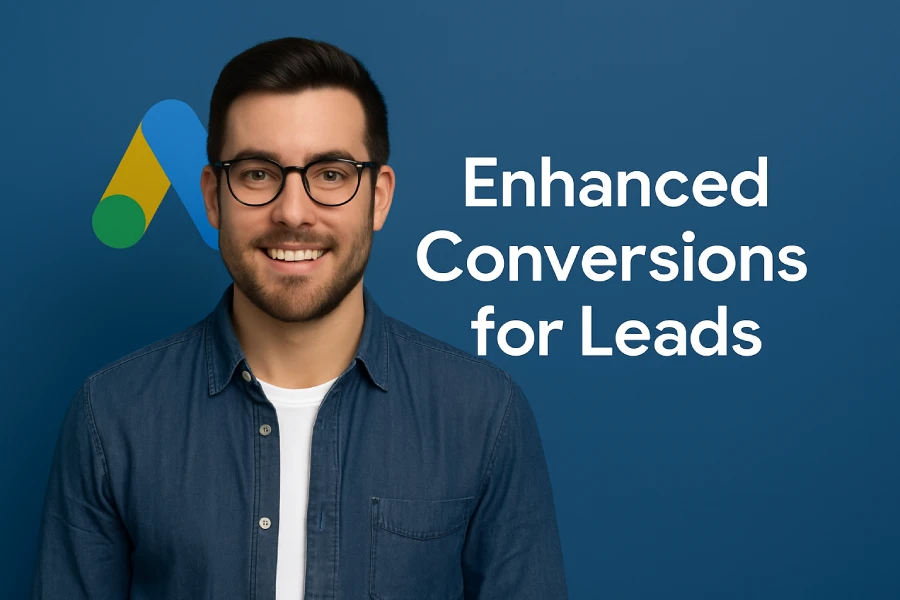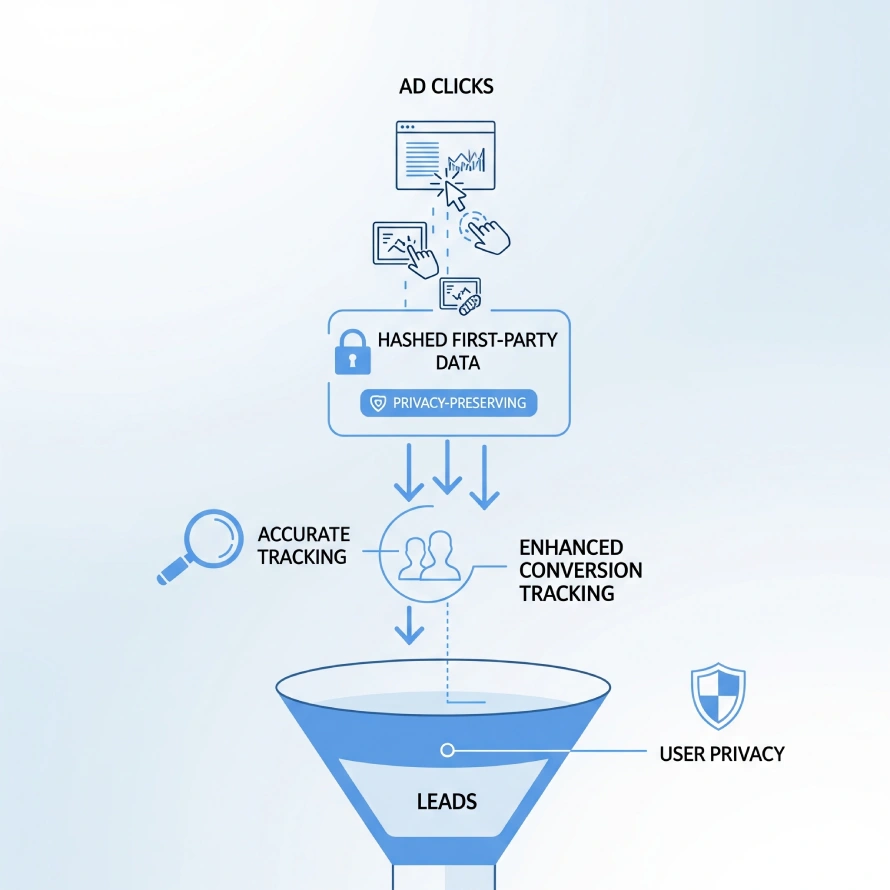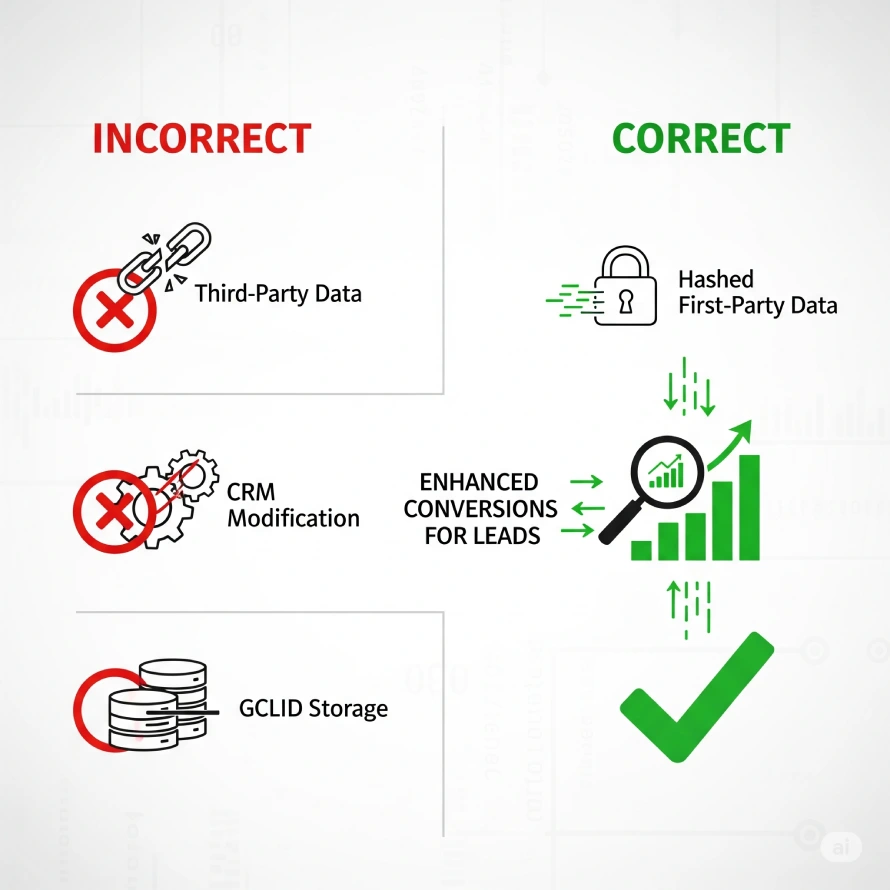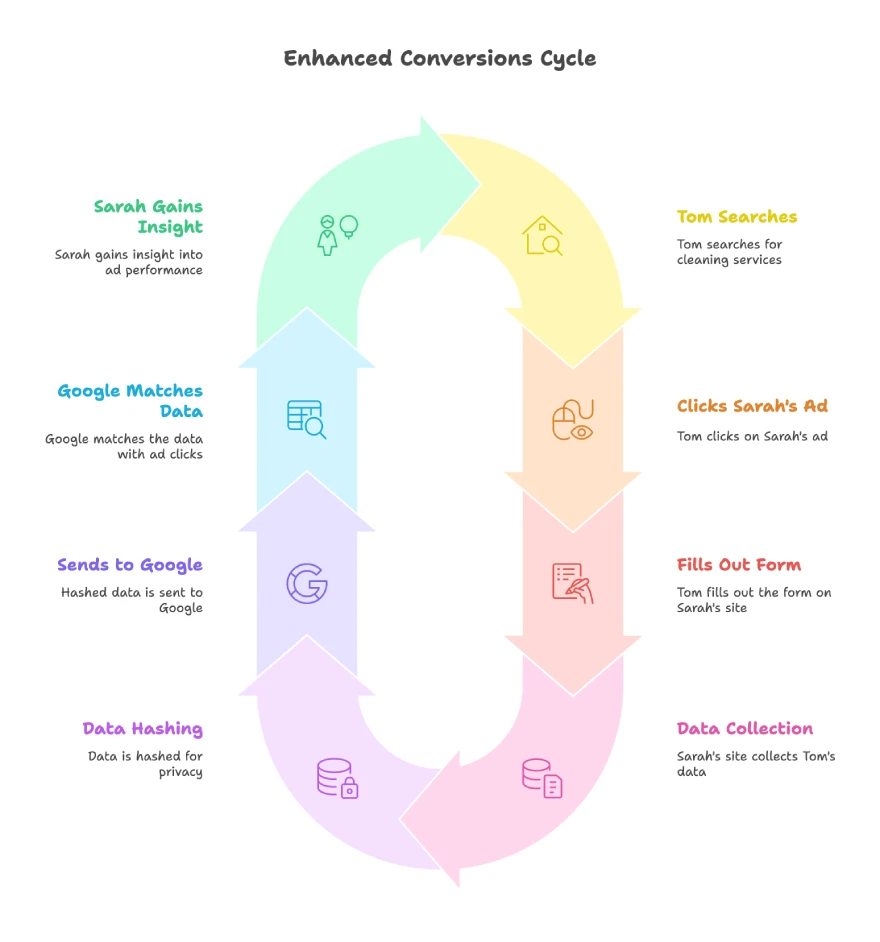The correct answer is “Uses hashed, first-party data“. Why is it correct, and why are the other options incorrect? In this content, I’ll discuss the full guidelines, and this question is also part of the Google Ads Measurement Certification. So, no delay. Let’s begin.
If you run ads for your business or help others with digital marketing, you know tracking leads is important. However, it can be hard to link leads to the ads that generated them. Enhanced conversions for leads help solve this problem.

Table of Contents
Exam Question
Which of the following can be used to describe enhanced conversions for leads?
A) Uses third-party data
B) Uses hashed, first-party data
C) Requires customer relationship management (CRM) system modification.
D) Requires Google Click Identifier (GCLID) storage
The Correct Answer
B) Uses hashed, first-party data
This is the correct answer. Now, let me explain why.
Why this answer is right
Enhanced conversions for leads help advertisers better understand what happens after someone clicks an ad and submits a form. When someone gives you their contact info like a phone number or email, on your website, that information is called first-party data because it comes straight from your visitor.
Google uses that first-party data in a special way. Before anything is shared with Google, the information is hashed. That means it’s scrambled into a string of letters and numbers so no one, not even Google, can see the real details. Hashing protects your users’ privacy but still allows Google to match that information with the person who clicked your ad.
By using hashed, first-party data, enhanced conversions let you see which ads are actually bringing in real leads. This helps you make better marketing decisions.

Why the other options are wrong
Let’s review the other options and explain why they don’t work.

A) Uses third-party data
This is incorrect. Third-party data comes from outside companies or other websites, not directly from your site visitors. For example, if you buy an email list from another company, that’s third-party data. Google does not use third-party data in enhanced conversions. They only use the information that your users share with you through your own website or app.
C) Requires customer relationship management (CRM) system modification
This one sounds confusing, but it’s also wrong. A CRM system like HubSpot or Salesforce helps you organize and manage your leads. While enhanced conversions may use data from your CRM, they don’t require you to change how your CRM works. There’s no need to rewrite your system or hire a developer to change anything major. You just need to collect and send the right data in the format Google expects.
D) Requires Google Click Identifier (GCLID) storage
Some types of ad tracking, especially offline conversions, do use GCLID, which is a code that helps Google track ad clicks. But enhanced conversions for leads do not require you to store GCLIDs. Instead, they match the hashed first-party data you send with what Google already knows from the ad click. That makes the process simpler and more secure.
Real-life example: Meet Sarah and Tom

Let’s make this real.
Sarah runs a small home cleaning service. She’s using Google Ads to get more people to visit her website and fill out her “Request a Quote” form.
One afternoon, Tom searches “affordable house cleaners near me” on Google. He clicks on Sarah’s ad and goes to her site. He fills out the form with his name, phone number, and email address so she can contact him with a quote.
That’s first-party data. Sarah’s site collects it and hashes it. This turns Tom’s info into a scrambled code that hides his identity. Then, Sarah’s system sends that hashed data to Google.
Behind the scenes, Google compares the code with its ad click records and sees that Tom had clicked Sarah’s ad. So now, Sarah knows this lead came from her Google Ads campaign.
She didn’t need to store the GCLID. She didn’t need to change anything in her CRM. She just used enhanced conversions the right way, and it gave her real insight into what her ad spend was doing.
Comparison: What you need to know
| Option | What It Means | Used in Enhanced Conversions? | Why or Why Not |
|---|---|---|---|
| A) Uses third-party data | Data from other websites or sources | ❌ No | Enhanced conversions only use what users give you directly |
| B) Uses hashed, first-party data | Info from your site, scrambled for privacy | ✅ Yes | This is exactly how enhanced conversions work |
| C) Requires CRM modification | Changes to your lead system or software | ❌ No | No major system changes are required |
| D) Requires GCLID storage | Saving click IDs for tracking | ❌ No | Enhanced conversions use user data instead of click codes |
Why this matters to you
If you’re running Google Ads and collecting leads through a website form, enhanced conversions give you a clearer picture of what’s working. You’ll be able to:
- Track leads more accurately
- Know which campaigns are performing best
- Keep user data private
- Improve ad targeting with better feedback
And the best part? You don’t need cookies, complex software, or expensive tools. You just need to collect form data securely and set up enhanced conversions in Google Ads.
Relevant resource links
Here are a few official links you can check out to learn more:
- Google Ads Help: About Enhanced Conversions
(Covers how enhanced conversions work and how to set them up) - Google Ads Help: Set Up Enhanced Conversions for Leads
(Step-by-step guide for setting it up with website forms)
Conclusion
Enhanced conversions for leads help advertisers link form submissions to ad clicks more accurately. They use hashed, first-party data to protect personal information while improving tracking.
You don’t need to store special tracking codes. You don’t need to modify your CRM. And you definitely don’t use outside data from other companies. If you’re running Google Ads and want better results without adding complexity, enhanced conversions for leads are worth exploring.
I hope you understand the question and how to choose the right option. Now, if you are ready, you can take the exam on Skillshop – Google Ads Measurement Certification. If you want more real exam questions and answers like this one, which have already been covered, follow along. I’ll be breaking down more Google Ads Measurement Certification exam questions with full solutions in the next posts on Google Ads!
FAQs
What’s the difference between first-party and third-party data?
First-party data is collected directly from your users through your own site. Third-party data comes from someone else’s site or business. Enhanced conversions only use first-party data.
What does “hashed” mean in simple words?
Hashing is like turning someone’s phone number into a long secret code. It hides the real number but keeps it useful for matching.
Do I have to save the GCLID to use enhanced conversions?
No. Enhanced conversions for leads do not require you to store the Google Click ID (GCLID). Matching happens through the hashed data instead.
Will I need to change my CRM system to use this?
No. Most businesses don’t need to change anything inside their CRM. You just need to collect and send the data in the correct format.
